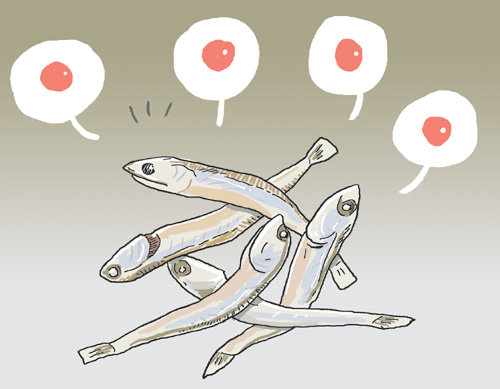The pure Korean words for anchovy
The pure Korean words for anchovy
Posted March. 06, 2020 07:48,
Updated March. 06, 2020 07:48

A few years back, I was doing my research on anchovy fishing on boats using fishing methods, such as anchovy tow net, drift gill net, and round haul net. I asked a fishing boat captain if I can ride along on his boat when he went fishing for anchovy. A few days later, I received a phone call from him. He told me to come to the waterfront at dawn as he would go fishing for “oba.” At first, I had no idea what he was saying. I asked fishing boat captains and crewmen I met why they use the Japanese names for anchovy. Their answer was all the same: “Because everyone does so.”
I asked my wife, who loves to make stir-fried anchovies and anchovy stock, if she knew what “kairi, goba, or juba” meant. She said no. Whenever dried anchovies were served at bars, I asked people on my table if they knew those Japanese words. No one exactly knew what they mean. Fisherman’s unions, the National Federation of Fisheries Cooperatives, and distributors persistently use the Japanese names consumers do not know. The reason to this traces back to 100 years ago. Japanese fishermen started to dominate the southern sea as migrant fishing villages were built around the southern coast, including Pohang, Ulsan, Geoje, Tongueong, Goheung, and Geomundo Island. Large-scale anchovy fishing operations using tow nets were held particularly near Geoje. Japanese words for anchovy started to take root as Japanese fishermen led the fishing, processing, and sales of anchovies.
Contrary to common belief, anchovy fishing and anchovy eating culture are not entirely the legacy of the Japanese colonial era. Our ancestors ate anchovies even before that. In the book “Ojuyeonmunjangjeonsango,” the writer Lee Gyu-gyung wrote that a boat was full of anchovies so the leftover was used as fertilizers after they went bad and dried anchovies were served up at table every day. In old books, such as “Uhaeieobo,” “Imwongyeongjeji,” “Jasaneobo,” and “Nanhoeomokji,” there are records of our ancestors eating dried anchovies and anchovy jeotgal (fermented fish).
Dried anchovies are classified for purpose (stir-fry or soup) and in size as “semyeol,” “jamyeol,” “somyeol,” “jungmyeol,” and “daemyeol.” But they are written in Japanese names, such as jiri, kairi, or juba with their purposes written in Korean in parenthesis. I am not trying to blame someone. I am just trying to give them the right Korean name. No one has succeeded in giving dried anchovies the right name. We have been indifferent to this issue for 75 years after the independence.
The most fished species in our waters for the past 10 years is anchovy. There are no fish that are served up at table more often than anchovy. Anchovies are consumed in a variety of ways, such as side dish, powder, jeotgal (fermented fish), and aekjeot (fish sauce). It is foolish to be insistent on using the Japanese names for anchovy. I want to see the Korean names for anchovy written on signs at dried fish markets. I propose to get rid of those Japanese names not because they are traces of imperialism. It is because we are using the names that are not even being used in Japan today. There are some things that should be preserved as lessons to take away and other things to throw away. It would be desirable to change the Japanese words into Korean words given the historical context of how those Japanese words spread. A language contains the spirit of the people.







